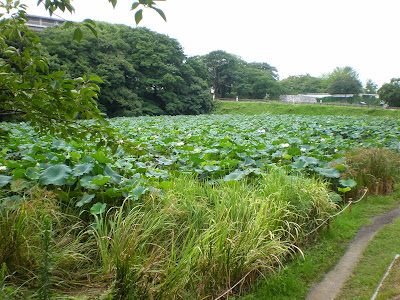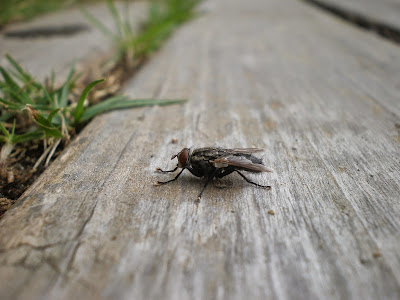I've met up with some of my language partners a few times now, and once the initial rush of emails was dealt with and I started actually meeting humans, things have generally been easier. It remains a bit tricky to some extent, because school timetables change every week and so you can't schedule a regular meeting slot or plan too far in advance, but it's not been a huge problem. And of course, if you're meeting people after work rather than in the daytime, that's doable.
A little while ago, one of my language partners (who I will call KM) took me off for a walk in the grounds of Fukuoka Castle that turn out to be conveniently near the school. It was a bright, sunny day and so somewhere around 30C in the shade, but we survived somehow (always bring a hat, and an umbrella, and a bottle of water).
Although we were strictly going to the castle, the fun really begins at the moats outside. A big chunk of these have turned into lotus forests, which have a nice soothing effect. They're unfamiliar enough to me as plants that I can easily kid myself I'm looking at some alien jungle, and detach myself from the actual scale of the plants to picture myself boating between the stalks in some floating forest on the moons of Jupiter.
The lotus forest harbours quite a bit of wildlife, though equally it's hard to see much. There are huge pond-skater creatures that look like many-jointed clockwork insects, and small near-transparent fish; on one leaf I saw a baby terrapin the size of a walnut, but unfortunately wasn't able to get any pictures.
Others may well not appreciate it, but I am personally made up with that photo of the fly, which is about my first ever successful use of the ultra-closeup feature on my camera.
A little further along is another moat that has been turned into a koi pond, where vast carp swim slowly through the murky waters while ducks float above. More excitingly, this is the home of the terrapins! As some of you already know, I have enormous affection for terrapins and all their kin, so this was a great joy to me, and we ended up spending quite some time admiring all these creatures.
When we passed by later, a family had been feeding the fish and gave us some leftover bread, to our slight embarrassment (I'm pretty sure they thought we were on a date and I was ill-prepared). This was a great opportunity to discover just how rambunctious, rude and downright alarming koi can get when there is food in the offing.
The water boiled in the feeding frenzy, a writhing mass of muscular fish, chomping fishy maws and bubbles, with everyone constantly shoving everyone else aside. The poor gentle terrapins were also striving to win some bread, but were constantly buffetted, squirmed over and sent flying underwater or aside by the koi - I was a bit worried for them at times, but they seem pretty tough. Perhaps wisely, the ducks made no attempt to intervene.
I can't be the only one who thinks the koi look genuinely creepy like that?
After a bit of practice, and some cunning divide and conquer on our part, we managed to lure enough fish away that it was possible to feed the poor terrapins. To my jubilation, a determined attempt to ensure it was indeed the terrapin that got my bread led to me being lightly nipped by one of them in the process of nabbing my bread, and it turned out that they will in fact accept feeding by hand. This alone made the trip probably my favourite afternoon in Japan so far.

There was a little bench nearby and a few birds sitting shyly in the trees or flitting back and forth overhead. I stopped to scatter a few crumbs on the path in the hope of getting some photos of these charming foreign birds, especially the unfamiliar corvids (possibly a jungle crow, but also something sparrowlike. To my surprise, they were extremely shy. Now usually in Britain, anywhere that people tend to drop food, birds quickly get bold and learn that it's safe to come and pack at the food, especially in places where they actually feed birds. Here was a place that people came to feed the fish and ducks, but apparently birds were scared to come near me. After sitting quietly for several minutes and leaving breadcrumbs in a long trail, eventually they were willing to come and snatch the furthest, but they never came within less than four yards of me. Twice they were interrupted, once by a walker and once by a runner, and in both cases it again took several minutes before they'd return to the ground. I don't know whether there's some cultural difference in how people interact with birds; maybe they frequently get chased away here by people trying to feed the fish? Anyway, a shame.



Eventually the teeming mass in the moat subsided, and all was quiet once more.
Anyway, we did also pay a visit to the actual castle ruins. The whole thing is entirely free, which makes it very much worth doing.
This area is under excavation at present. It used to be a diplomats' lodge (鴻臚館 korokan) until around the 11th century. It's the only one that has been found in all Japan, so apparently this is something of a big deal. It just looks like a field right now, sadly.
It's notably different to a typical British castle. There is a substantial garden-like area within the moat, and as I understand it, it was basically more like a fortified complex than a castle as we'd understand it, with a central keep that was the main defensive point. This is now a little park, though orginally there would have been various buildings (and no visitor centre!). There are shady trees, including some odd hairy ones that I didn't recognise at all.
This is a 藤棚, a wisteria trellis. It pleases me that there's a specific term for a wisteria trellis, although sadly it is a compound noun rather than its own unique term.
The castle walls are stone, but nothing else. They have a steep angle rather than a flat wall, probably for architectural reasons. An interesting thing to me was that they seem to be built essentially by dry stone walling, with very rough stones of varying sizes carefully formed into a massive fortress wall.


I read somewhere that this technique helped protect the castles from earthquakes: without mortar and being only partly fitted, the stones could shift slightly without breaking the overall structure, and so could survive even cumulative minor earthquakes. The top part was basically a wooden structure, which was largely fireproof because of the thick layers of plaster and the tile roofs. Although Japan did have gunpowder (unsurprisingly, it's near China), it doesn't seem like they had similar tactics to the Europeans (I don't know about Chinese tactics); anyway, some combination of tactical philosophy and technology means that they didn't develop the siege-resistant stone castles of Europe. I think it was more common to sally forth and meet the enemy in the field.
There's very little left other than the castle walls, but you can get the best view I've yet seen of Fukuoka from the top.



I was intrigued by the way the complex has been integrated into the city. In Europe, abandoned castles near towns have usually been plundered for stone; KM was very surprised, and a bit shocked, when I told her that. I suspect the difference here is that European castle architecture involved a very large quantity of finely-masoned stone. The stone itself, its transport costs from a quarry far away, and the masonry work all added up to a considerable value, and so there was a lot to be gained from looting a castle ruin. Also, because most of the castle was stone, once left to rot it would quite readily start falling apart and you could fetch away useful bits, even without making a concerted effort to dissassemble it. And of course, in Europe a lot of buildings were made of stone, from castles to churches to manor houses to posh barns, and even some wealthy farmers' houses. In Japan, most things seem to have been made from wood and plaster for the majority of history (possibly related to all those earthquakes), and so there was less demand for stone. Even if you did loot the stone, for most purposes you'd need to get it masoned, and so you wouldn't be saving very much.
On the other hand, I have yet to see any historical site in Britain that is more or less extant, but where someone has fairly recently been allowed to build a sports pitch in the middle of the grounds.
There are several of these; at one time apparently a nasty concrete baseball stadium was also present. I can only shrug.
As we were wandering round, I saw some tourists with some kind of tablet device. It turned out that these are visualisation tools. Basically, you can hold it up anywhere in the site, and it will show you a reconstructed view of the old castle from that spot: buildings, walls and so on are recreated for you. It can't be long before they offer a headset version, surely? Anyway, we didn't get round to trying that, but it seems very cool and I'd recommend looking into it if you go. I suspect you get them from the museum. The museum also has displays, and a large model/map combination of the castle area as it was. The staff there were very helpful in explaining how the model mapped onto the modern city, as some bits have changed very substantially. It turns out a bit chunk of the waterfront area has been reclaimed from the sea. KM very kindly helped interpret for me, though the staff obviously had some English.
For other GenkiJACS students: this is very definitely worth a visit, and it's so close to the school that you could go for a quick wander there at lunchtime, if you wanted, or even eat lunch in the grounds (I saw people doing that). It's one of the best days out I've had and I heartily recommend it. It was a really good way to spend a conversation session, because it gave us loads to talk about, from nature to history, politics and society. If you have a well-informed conversation partner, or some other Japanese friend interested in such things, then definitely set aside a couple of hours to wander around at your leisure and make the most of it. There's a cafe or two nearby to recover afterwards.

An odd note to finish on, but I was genuinely struck by this on leaving the grounds. I'm pretty sure this is the only segregated pavement I've seen since arriving in Fukuoka. Everywhere else, bikes fly around at tremendous speed in total silence, passing by pedestrians like a school of dolphins weaving past clumsy divers, and with about the same non-existent clearance between you. It's highly alarming, to be quite honest. For some reason, this pavement has been singled out for a great honour. It's probably just because it's wide, but there you go.



















































